Auction: 21003 - Orders, Decorations and Medals
Lot: 391
A notable Second World War Mediterranean operations campaign group of six awarded to Gunner (T.) A. E. Shaw, Royal Navy, afterwards a Senior Commissioned Engineer (Air) in the Fleet Air Arm
In a fraught period of operations in the H.M.S. Ajax in 1940-41, Shaw was present at some spectacular encounters of the close-range variety, in addition to lending valuable service at the evacuation of Greece and Crete
Likely the most memorable was a night action fought off Cape Passero in October 1940, when Ajax closed the range to 300 yards and laid waste elements of the Regia Marina's 12th Destroyer and 1st Torpedo Boat Flotillas: for a loss of 13 killed and 22 wounded, she destroyed two torpedo boats and damaged two destroyers, one of them fatally so
1939-45 Star; Atlantic Star, clasp, France and Germany; Africa Star; Defence and War Medals 1939-45; Royal Navy L.S. & G.C., G.VI.R., 1st issue (J. 112031 A. E. Shaw, A./L.S., H.M.S. Ajax), mounted as worn, generally very fine (6)
Arthur Ernest Shaw was born at Grimsby, Lincolnshire on 25 March 1908 and entered the Royal Navy as a Boy 2nd Class in October 1924.
An Able Seaman at the shore establishment Vernon on the outbreak of hostilities in September 1939, he removed to H.M.S. Ajax in April 1940 and was still likewise employed at the time of his promotion to Acting Temporary Petty Officer in March 1941; he was awarded his L.S. & G.C. Medal in the following month.
It is therefore possible to deduce that he saw much action in the Mediterranean, Ajax winning five Battle Honours in the same period.
Cape Passero: point-blank encounter of the spectacular kind
In August 1940, Ajax was allocated to the 7th Cruiser Squadron in the Mediterranean and quickly found herself deployed to the Malta run.
On the night of 11-12 October 1940, she intercepted an Italian force off the south-east coast of Sicily and a close-range night action ensued - sometimes called the battle of Cape Passero. No better summary of events may be quoted than an article by Vince O'Hara on the Regia Marina Italiana website:
'On October 8 the full weight of the Mediterranean fleet, four battleships, two carriers, a heavy cruiser, five light cruisers and sixteen destroyers, departed Alexandria to provide distant cover for a Malta bound convoy of four steamers. Hidden in part by heavy weather, the convoy made port on October 11 undetected by the Italians. That same day, however, an Italian civil aircraft flying to Libya reported elements of the Mediterranean fleet about 100 miles southeast of the island where they were loitering, waiting to escort three empty cargo vessels back to Alexandria that night. Supermarina had reservations about this sighting because no military aircraft confirmed it; nonetheless, they dispatched several groups of light units to patrol potential transit areas.
They ordered the largest group, 11th Destroyer Flotilla, Artigliere, Aviere, Geniere and Camicia Nera, under Captain Carlo Margottini, supported by the 1st Torpedo Boat Flotilla, Airone, Alcione and Ariel, under Commander Alberto Banfito to guard the waters east of Malta. Admiral Cunningham, sailing aboard his flag Warspite, established a scouting line of cruisers extending north from his force. The wing ship, the light cruiserAjax, Captain E. D. B. McCarthy, was zig-zagging at 17 knots about seventy miles north of the convoy and about the same distance east, north-east of Malta.
The weather was moderating from earlier thunderstorms. The moon was up and very bright, just four days short of full. The 1st Torpedo Boat Flotilla was proceeding at 17 knots in a long line of bearing with each ship about 5,000 meters or 5,400 yards apart. Alcione saw Ajax first at 0135 hours on October 12 from about 18,000 meters (19,600 yards). Undetected by the cruiser, Alcione reported her contact, requested assistance and proceeded directly to the attack. At 0142 Airone, followed shortly thereafter by Ariel, sighted the cruiser and followed their flotilla mate in. Alcione approached Ajax undetected and fired two torpedoes at Ajax's port side from a range of just 1,750 meters (1,900 yards). She then turned away to attack from another direction.
Her half-salvo missed its target. At 0155 Ajax finally spotted two strange vessels silhouetted against the bright moonlight, one on either side of her bow just several thousand yards off. These vessels were Airone and Ariel. One minute later Airone fired two torpedoes from a range of only 2,000 yards. Ariel followed at 0157 with two more. Ajax flashed a challenge, and, receiving an inappropriate reply, increased speed and altered course. The four torpedoes all ran wide, although at this point Ajax was still uncertain whether or not she was under attack.
Airone, closing rapidly, fired off another pair of torpedoes from 750 yards (also wide) and resolved Ajax's confusion by opening fire. She snapped off four quick salvos, hitting Ajax twice on her bridgeworks and once six feet above her waterline, igniting a fire in a storeroom. The range was down to slightly more than 300 yards when Ajax finally returned fire. Her 112-pound shells smashed the Italian torpedo boat and left her dead in the water. The two antagonists were so close, Ajax's machine guns could sweep Airone's deck. Ajax reduced speed to 25 knots and shifted heading constantly to avoid torpedoes and gunfire. She fired two torpedoes of her own, one of which might have hit, adding to the misery of Airone's crew.
With Airone in a sinking condition, Ajax turned the attention of her main batteries to Ariel, returning her fire and quickly scoring one hit from 4,000 yards. This may have penetrated a magazine because Ariel blew up and sank within a few minutes, taking most of her crew with her. The time was 0214. When Alcione finally returned from her extended manoeuvre she found the British ship gone, Ariel sunk and Airone on fire and slowly following. She could do nothing but rescue survivors, saving 125, about half the complement of the two ships. Airone finally went under at 0235.
Meanwhile, the 11th Destroyer Flotilla, alerted by Alcione's original message of forty-five prior was hurrying to the battle in an extended column with Artigliere leading followed by Aviere, Camicia Nera and Geniere. Aviere found the British light cruiser first, but Ajax was fully alert and, at 0218, she hit Aviere lightly on her bow before the Italian could fire any torpedoes. Aviere turned and lost contact. Artigliere, the flotilla flagship, came in next. Manoeuvering at high speed she fired a single torpedo at Ajax's starboard side, which missed, and began trading gunfire with the cruiser. Initially the Italian, steaming at a high speed and zig-zagging got the better of the exchange, hitting Ajax four times, putting out her radar and knocking out one of her 4" secondary battery.
The moon had just set; reducing the general illumination and depriving Ajax of the backlight that made the Italian ships, stand out. Not equipped with flashless gunpowder, the repeated flashes from Ajax's guns blinded her crew with every salvo. Nonetheless, at 0230 Ajax's gunners finally hit the elusive Artigliere and hit her hard, killing the flotilla commander, Captain Margottini and bringing her to a halt. By 0232 Artigliere was dead in the water and her guns silent. The other two destroyers of the flotilla remained in the offing. Camicia Nera and Ajax exchanged ineffective salvos from about 5,500 yards. Ajax believed she was facing two cruisers, so when Nera disappeared into a smoke screen of her own devise, Ajax used the opportunity to break contact and turn toward the fleet. Geniere, following at some distance, never entered action.
The remainder of Ajax's squadron concentrated on Ajax's position, but arrived too late to see any action. Ajax suffered 13 killed and 22 wounded in this action. She expended 490 6" shells and 4 torpedoes. Ajax's damage was patched up in a couple of weeks and she was back in action by November 5. Camicia Nere took Artigliere in tow, but she was forced to abandon the damaged ship the next morning when two British cruisers and four destroyers approached. The British heavy cruiser Duke of York finished off Artigliere at 0905 with torpedoes. Italian reinforcements of three heavy cruisers and three destroyers sailing from Messina arrived too late to save Artigliere or to engage the Duke of York group.'
In June 2017, the wreck of the Artigliere was discovered by a research team led by Paul Allen, the billionaire co-founder of Microsoft, who is a marine archaeology enthusiast.
On 12 November 1940, near the Strait of Otranto, Ajax and her consorts in Force X intercepted a small convoy of four Italian merchant ships escorted by the naval auxiliary Ramb III and the torpedo-boat Nicola Fabrizi. Ramb III fired 19 salvoes and succeeded in breaking away without suffering any damage.
The Nicola Fabrizi stayed with the merchant ships and attacked the British force. As a result, she was hit immediately and suffered serious damage. The Italian torpedo boat continued to fight and retired badly damaged. After Nicola Fabrizi was neutralized, the British force divided up the targets and sank all four of the Italian merchant ships.
Greece and Crete
Having then participated in the battle of Cape Matapan in the interim, Ajax was heavily engaged in the evacuation of our troops from Greece and Crete.
On the night of 27-8 April 1941, she and three destroyers went to pick up 5,000 men from Greece, including the 4th New Zealand Brigade, which had formed the rearguard. And it fell to Ajax to embark General Freyberg and Rear-Admiral H. T. Baillie-Grohman; the latter, who had originally gone to Athens on the 15th, was in charge of the embarkation operations, and so remained ashore until the last moment.
Next up was the evacuation of Crete and it was during one such trip on the night of 21 May 1941 that Ajax and her consorts came upon an enemy convoy about 18 miles north of Canea. The convoy was escorted by motor torpedo boats, one of which was the first victim. The Dido was close enough to her to pour in fire from multiple pom-poms, and she was blown to pieces by a broadside from Ajax. The destruction of the whole convoy, in which it was estimated 4,000 enemy troops were being taken to Crete, occupied less than two hours.
One week later, at dawn on the 28th, en route to Heraklion, Ajax fell victim to sustained air attack. She was ordered back to Alexandria, having suffered severe damage and casualties.
She then covered Syrian operations in June and joined Force K at Malta in November, being withdrawn in February 1942 for refit.
Postscript
Shaw came ashore to Vernon and was commissioned as an Acting Gunner (T.) on 24 May 1943. Shortly afterwards, he joined the destroyer Duncan, in which ship he served on the north Atlantic-run and, by the war's end, he was serving in another destroyer, the Troubridge.
Post-war, he transferred to the Fleet Air Arm and retired as a Senior Commissioned (Air) Engineer in the mid-1950s.
Subject to 20% VAT on Buyer’s Premium. For more information please view Terms and Conditions for Buyers.
Sold for
£380
Starting price
£110









